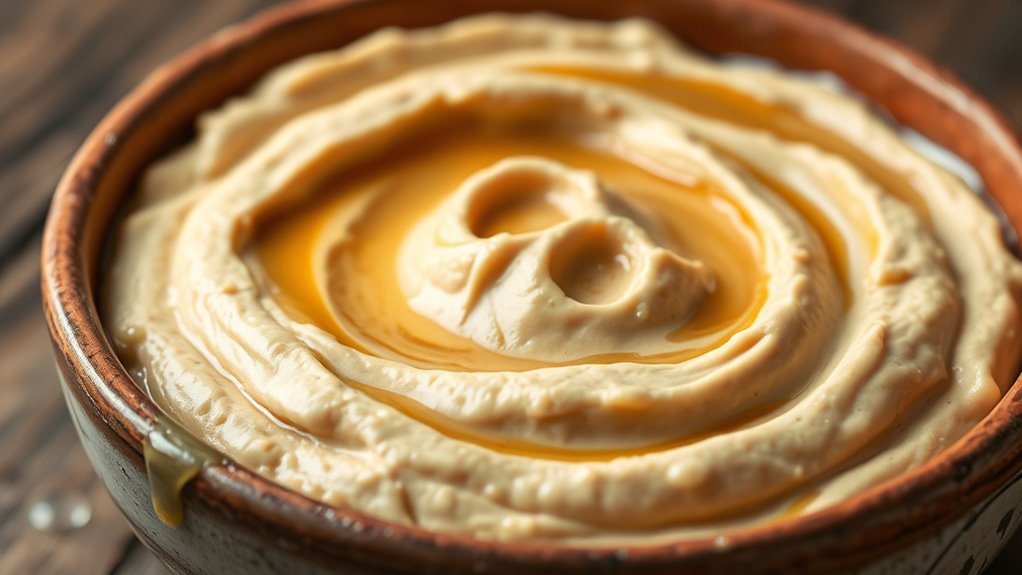To prevent hummus from breaking or becoming greasy, focus on proper temperature and tahini ratios. Use room temperature ingredients to help the emulsion stay stable—cold or hot ingredients can cause separation. Also, maintain a balanced tahini amount, about 1/4 cup per cup of chickpeas, since too much makes it pasty, and too little results in a runny texture. Mastering these factors can boost your hummus’s consistency—keep exploring to learn more.
Key Takeaways
- Proper emulsion stability depends on balancing ingredient temperature; room temperature ingredients prevent separation.
- Too much tahini thickens hummus and increases risk of emulsion breakage, while too little causes watery consistency.
- Warm ingredients can destabilize oil, making emulsion prone to separation; cold ingredients hinder proper blending.
- Using high-quality, fresh tahini enhances emulsion stability and reduces separation issues.
- Adjusting both temperature and tahini ratios is crucial for achieving a smooth, stable hummus.

Hummus emulsion failures are common pitfalls that can ruin an otherwise perfect batch. One of the most frustrating issues is oil separation, which leaves your hummus looking greasy and unappealing. This often happens when the emulsion breaks, and the oil refuses to integrate smoothly into the mixture. When your hummus separates, it not only affects the appearance but also impacts the texture, making it gritty or overly runny. These texture issues can make the hummus unpleasant to eat and diminish its creamy consistency.
Understanding how temperature influences emulsion stability is essential. If your ingredients are too cold, the tahini and chickpeas won’t blend well, leading to a stubborn, lumpy texture and increased risk of separation. Conversely, if the ingredients are too warm, the oil can become too liquid, causing difficulty in maintaining a stable emulsion. Ideally, you want your ingredients to be at room temperature; this balance helps the oil incorporate more effectively, creating a smooth, cohesive mixture. If you notice oil separation early on, it’s a sign that the temperature isn’t ideal, and adjusting your ingredients’ temperature can often fix the issue. Temperature control is a crucial factor in maintaining emulsion stability. Additionally, ingredient quality can influence how well your emulsion holds, as fresher, high-quality tahini tends to emulsify more reliably.
Ratios of tahini to other ingredients also play a pivotal role in preventing emulsion failure. Using too much tahini can make the hummus thick and pasty, which hampers proper emulsification and leads to texture issues. It also increases the risk of oil separation because the high fat content can break the emulsion if not balanced properly. On the other hand, too little tahini results in a watery, thin hummus that doesn’t hold together well. Achieving a proper ratio—generally about 1/4 cup of tahini for every cup of chickpeas—helps maintain the right consistency and prevents the mixture from breaking down.
When mixing your hummus, start slow and add the oil gradually, especially if you’re using a blender or food processor. This slow incorporation allows the emulsion to form steadily, reducing the chances of oil separation. If you notice the mixture starting to split, stopping and blending in a little cold water or adding a splash of lemon juice can often help re-emulsify the mixture. Remember, patience and gradual adjustments are key. Pay attention to your ingredient temperatures, keep ratios balanced, and add oil carefully, and you’ll markedly reduce the likelihood of emulsion failures, ensuring your hummus ends up creamy, smooth, and perfectly textured every time.
Frequently Asked Questions
Can Adding Lemon Juice Prevent Hummus Emulsion Failures?
Adding lemon juice can help prevent hummus emulsion failures by increasing lemon juice acidity, which enhances emulsification stability. The acidity from lemon juice breaks down the fats and proteins, making it easier for the oil and water to blend smoothly. Incorporating lemon juice gradually while blending guarantees a stable, creamy hummus. So, yes, lemon juice not only adds flavor but also promotes better emulsion stability in your hummus.
What Role Does Blending Speed Play in Emulsion Stability?
You might wonder how blending speed affects emulsion stability. When you blend too fast, you risk breaking the emulsion, leading to a runny or split hummus. Conversely, blending at a moderate speed allows the ingredients to emulsify properly, creating a smooth, stable texture. Slow and steady blending promotes better emulsification stability, ensuring your hummus stays creamy and well-mixed. Adjust your speed accordingly to achieve the perfect consistency.
Are There Specific Tahini Brands That Reduce Failure Risks?
When choosing tahini, you want a brand with consistent tahini consistency to guarantee your hummus turns out smooth and stable. Some brands are known for better brand stability, which reduces the risk of emulsion failures. Look for options that mention natural ingredients and minimal separation. By selecting a reliable tahini brand, you’ll minimize issues and achieve a creamy, well-emulsified hummus every time.
How Does Humidity Affect Hummus Emulsification?
Humidity affects hummus emulsification by increasing moisture absorption, which can make the mixture too watery and difficult to stabilize. High humidity also promotes air entrapment during blending, leading to a less smooth texture and potential separation. To prevent this, keep your ingredients dry and work in a controlled environment. Using minimal water and ensuring your tahini is fresh helps maintain the emulsion, even in humid conditions.
Can Alternative Oils Improve the Emulsion Process?
Think of emulsion like blending oil and water—you need the right tools. Alternative oils, like avocado or walnut, can boost flavor and improve emulsification techniques, making your hummus creamier. They often contain different fat profiles that help stabilize the mixture better than traditional oils. You might find that experimenting with these options results in a smoother, more stable hummus, especially if your usual tahini ratios aren’t giving you the desired texture.
Conclusion
Understanding hummus emulsion failures is like balancing on a knife’s edge—you need the right temperature and tahini ratio. Too hot, and the emulsion breaks; too cold, and it’s too thick to blend smoothly. Without the perfect ratio, your hummus won’t be creamy or stable. So, think of it as a delicate dance: mastering temperature and proportions guarantees a luscious, stable hummus, while neglecting either turns your smooth spread into a disappointing split.









